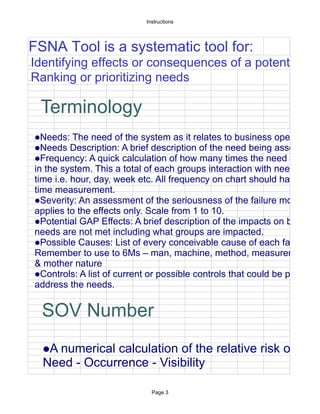Fsna tool
- 1. FSNA Future System Needs Assessment System Type: Prepared by: Responsible: FSNA Date (Orig) ______________ (Rev) _____________ Needs Needs Description Potential Gap Effects Frequency O Controls V S C I E C S What is the need Why is this a What is the impact on the V How often is the need U What are the existing or controls and or I being assessed? system/business need? business if need is not met? E presented (estimate)? R procedures to address if the need is not B SOV R R met? I Number I E L T N I Y C T E Y 0 0 0 0 0 0 0 0 0 0 0 0
- 2. ***Any column with a score of 8 or higher is considered critical and is a "must have" for any new system options****
- 3. Instructions FSNA Tool is a systematic tool for: â Identifying effects or consequences of a potential sys â Ranking or prioritizing needs Terminology ïŽNeeds: The need of the system as it relates to business operations. ïŽNeeds Description: A brief description of the need being assessed. ïŽFrequency: A quick calculation of how many times the need represe in the system. This a total of each groups interaction with need and c time i.e. hour, day, week etc. All frequency on chart should have the s time measurement. ïŽSeverity: An assessment of the seriousness of the failure mode. Sev applies to the effects only. Scale from 1 to 10. ïŽPotential GAP Effects: A brief description of the impacts on business needs are not met including what groups are impacted. ïŽPossible Causes: List of every conceivable cause of each failure. Remember to use to 6Ms â man, machine, method, measurement, m & mother nature ïŽControls: A list of current or possible controls that could be put into p address the needs. SOV Number ïŽAnumerical calculation of the relative risk of a pa Need - Occurrence - Visibility ïŽVOC = Severity x Occurrence x Visibility Page 3 SEV x OCC x VIS
- 4. ïŽAnumerical calculation of the relative risk of a pa Need - OccurrenceInstructions - Visibility ïŽVOC = Severity x Occurrence x Visibility SEV x OCC x VIS ïŽThisnumber is then used to place priority on whic need must be addressed by system options Number Severity to Occurrence of the Organization Need 10 Very high risk without manual Very high (multiple times an hour by process multiple groups) 9 Very high risk with difficult Very high (hourly) workaround 8 Very high risk Very high (multiple times a day) 7 High risk Daily (1x a day) 6 Moderate risk High (2-3 a Week) 5 Low risk Moderate (Weekly) 4 Very Low risk with workaround Moderate (2x a Month) 3 Minor risk Low (1 a Month) Page 4
- 5. Instructions 3 Minor risk Low (1 a Month) 2 Minor risk with simple workaround Low (Quarterly) 1 Little risk with simple workaround Remote (1 â 2 times a year) Page 5
- 6. Instructions potential system needs not being met. ess operations. ng assessed. e need represents itself ith need and common ould have the same lure mode. Severity cts on business if . each failure. easurement, materials ld be put into place to risk of a particular ity Page 6
- 7. risk of a particular Instructions ity ority on which items ions e Visibility es an hour by Every group and process will noticed and be impacted Every group and process will be impacted es a day) Every person and group will be impacted Most groups and processes will be impacted Most groups will be impacted or notice Many groups and processes impacted Several groups processes impacted Some people groups impacted Page 7
- 8. Instructions Some people groups impacted Few people impacted year) No one will notice or be impacted Page 8








